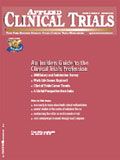Welcome to the 21st Century
Applied Clinical Trials
The need for collaboration between the various disciplines and stakeholders is becoming crucial.
It is no secret that the pharma industry is experiencing a particularly bad patch. A simple reading of the numbers tells the story. In 2007 FDA approved just 17 new molecular entities (NMEs), the lowest number since 1983. Obviously the industry's R&D engine is lagging. Companies are just not able to fill their pipelines with drugs that won't fail at the last crucial hurdle. While the industry spent $3.2 billion on R&D in 1983, that figure grew to $43 billion in 2007. This means that industry spending per approved NME increased from $228 million in 1983 to $2.5 billion in 2007. These figures, read together, tells us that something needs to be done and done immediately.

Eric Paternoster
At the center of the issue is R&D productivity. Today's trials are more complex, involve more people, and are often geographically spread out. Needless to say, they are more expensive. Yet, the need to hit the market first is more acute: While the first brand in the market captures 40% to 60% of the market, the second manages only around 15%—and being third means negative business.
Of course, there is no silver bullet to solve the problem. However, there are some obvious steps the industry must take to emerge out of the current impasse.
Breaking through
One step is to standardize data and protocols to enable interoperability. Though CDISC has been around for nearly 10 years, the industry is yet to fully adopt its standards. Implemented at the beginning of a study, CDISC standards are estimated to provide savings of 70% to 90% on start-up time and cost. And standard protocols will allow semantic interoperability.
Second is the dependency on paper-based processes. Not only do they prolong study time, they also cost more and can introduce errors. Paper intensive processes have been the bane of other industries, like banking and insurance, which have gone on to eliminate paper. Similarly, the pharma industry needs to redesign trial processes for efficiency and then automate where possible.
With many companies and research centers emphasizing translational research—lab studies that are brought almost directly to small cohorts of patients to test hypotheses of improved diagnosis or therapy—the need for collaboration between the various disciplines and stakeholders is becoming crucial. For effective collaboration, data standardization, integration, and interoperability are essential.
Information management is another important area in which pharma companies need to pay attention. The entire clinical development process generates an enormous amount of data, which is not efficiently used. If this information is integrated with that from the discovery phase and postmarketing studies, companies can tease out important insights that could result in new drugs or help avoid costly failures.
To sum up, scientists and clinicians are trying to implement next-generation approaches to drug discovery and development using last-generation technical infrastructures, business processes, and rules. Tomorrow's successful companies will form governance bodies at the highest level, do their homework to understand the dimensions of the problem, prioritize corrective action into a multiyear playbook, and bring their operational practices into the 21st century.

Improving Relationships and Diversifying the Site Selection Process
April 17th 2025In this episode of the Applied Clinical Trials Podcast, Liz Beatty, co-founder and chief strategy officer, Inato, discusses a number of topics around site engagement including community-based sites, the role of technology in improving site/sponsor relationships, how increased operational costs are impacting the industry, and more.